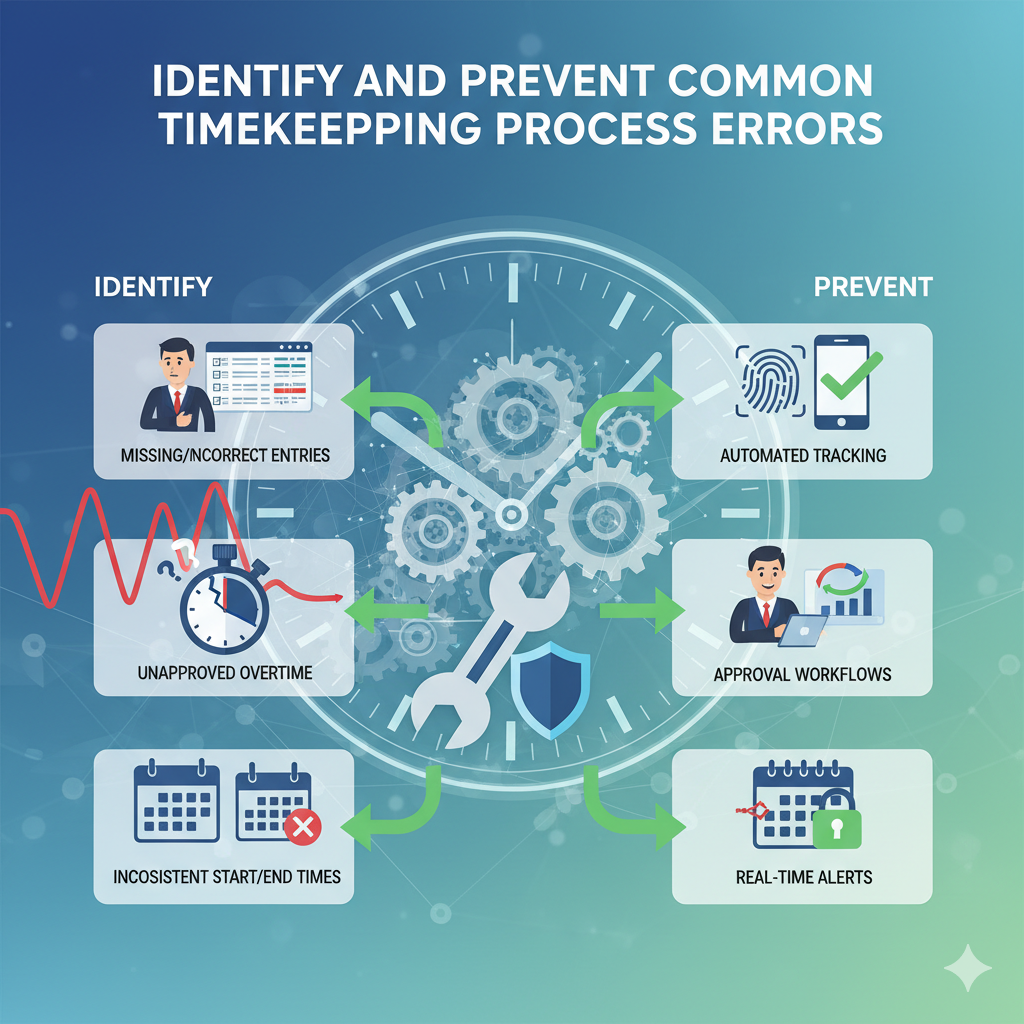Address
Kaypian, San Jose Del Monte City, Bulacan Philippines
Work Hours
Monday to Friday: 8AM - 6PM
Weekend: 10AM - 5PM
Address
Kaypian, San Jose Del Monte City, Bulacan Philippines
Work Hours
Monday to Friday: 8AM - 6PM
Weekend: 10AM - 5PM


Integrated HR. Accurate Payroll.


Integrated HR. Accurate Payroll.

Accurate timekeeping is the backbone of productivity, payroll accuracy, and operational efficiency. Yet, many organizations still struggle with timekeeping errors that lead to compliance risks, inaccurate labor costs, and frustrated employees. Understanding where these errors originate—and how to prevent them—is crucial to maintaining a smooth and transparent workflow.
In this article, we’ll explore the most common timekeeping process errors, how to identify them early, and effective strategies to prevent them.
a. Missed or Incomplete Clock-Ins/Clock-Outs
Employees forgetting to clock in or out is one of the most frequent timekeeping mistakes. This can lead to inaccurate total hours, affecting payroll and compliance with labor laws.
Example: An employee clocks in late or forgets to clock out, and their total hours appear shorter or longer than they actually worked.
b. Manual Data Entry Mistakes
When time is entered manually—on spreadsheets or handwritten timesheets—human error is inevitable. Simple typos can cause significant discrepancies.
Example: An extra zero added by mistake turns an 8-hour day into 80 hours.
c. Inconsistent Timekeeping Practices
Without standardized processes, each department or team might record time differently. This inconsistency creates confusion and makes auditing difficult.
Example: One team rounds time to the nearest 15 minutes, while another records exact times.
d. Lack of Real-Time Monitoring
Relying on outdated systems that don’t capture attendance data in real time makes it hard to identify missing entries or irregular patterns until it’s too late.
Example: Payroll discovers missing records only after the pay period has closed.
e. System Integration Failures
When your timekeeping system doesn’t integrate properly with payroll or HR platforms, data can be lost or duplicated.
Example: Approved overtime doesn’t sync with payroll, resulting in underpayment or delayed compensation.
a. Conduct Regular Audits
Regularly review time records for anomalies—like duplicate entries, excessive rounding, or missing clock-ins. Automated reports can flag unusual patterns quickly.
b. Compare Time Logs with Payroll Data
Cross-check timekeeping data against payroll summaries. Any inconsistencies between worked hours and paid hours should raise a red flag.
c. Monitor Employee Feedback
Employees often notice timekeeping issues first, especially if their paychecks are affected. Encourage open communication and quick reporting of discrepancies.
d. Use Analytics and Reporting Tools
Modern timekeeping systems offer analytics that can highlight trends in lateness, absenteeism, or missed punches. These insights can reveal deeper process issues.
a. Automate Time Tracking
Switch from manual methods to digital timekeeping systems. Automation reduces human error and ensures real-time accuracy.
b. Standardize Procedures
Establish clear company-wide policies on how and when to record time. Training all employees and supervisors on these standards ensures consistency.
c. Integrate Systems
Ensure your timekeeping software integrates smoothly with payroll, scheduling, and HR systems. Integration minimizes data loss and redundancy.
d. Provide Employee Self-Service Access
Allow employees to view and verify their time records before payroll submission. Transparency helps catch errors early.
e. Schedule Routine Maintenance and Updates
Keep your timekeeping software updated. Outdated systems are more prone to bugs and integration issues.
Implementing robust timekeeping processes not only prevents payroll errors but also boosts overall efficiency. Accurate data supports better forecasting, compliance with labor laws, and improved employee satisfaction.
In short: When timekeeping is precise, everyone benefits—employees are paid correctly, managers gain reliable insights, and the business saves both time and money.
Timekeeping might seem like a small administrative task, but its impact is significant. By identifying common errors early and implementing preventative strategies, organizations can create a more reliable, transparent, and efficient timekeeping process.
Remember, time is one of your most valuable resources—make sure you’re keeping it accurately.